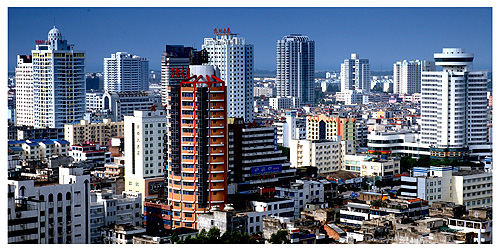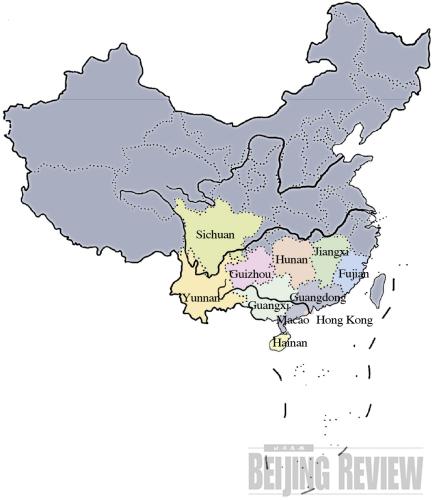|
 |
|
EMERGING POWER: Beihai of Guangxi Zhuang Autonomous Region, the major port targeting the ASEAN market, has become an important player in the Pan-Pearl River Delta LIANG SIQI |
If one compares China's territory to a rooster, then the Pan-Pearl River Delta would be the bird's belly. The Pan-Pearl River Delta covers Fujian, Jiangxi, Hunan, Guangdong, Hainan, Guizhou, Yunnan and Sichuan provinces, Guangxi Zhuang Autonomous Region, Hong Kong and Macao. The region has a population of 457 million, or 34.8 percent of the country's total. It covers an area of 2 million square km, or 20.9 percent of the country's total land.

The belly of the rooster is also the most productive and abundant part of China. In 2008, the total GDP of the eight provinces and Guangxi reached $1.59 trillion, accounting for 36.9 percent of the country's total.
But the sweeping global financial crisis has taken a heavy toll on the region.
"Hong Kong and Macao, and the eastern coastal Guangdong and Fujian, were hit hardest by the financial crisis," said Fan Hengshan, Director of the Regional Development Department under the National Development and Reform Commission, at the Fifth High-level Forum on Pan-Pearl River Delta Regional Cooperation and Development in Nanning, the capital city of Guangxi Zhuang Autonomous Region, on June 9-13.
From January to May, Guangdong, one of the major export provinces, witnessed an 18.5-percent drop in exports year on year, while Fujian saw a 15.7-percent decrease.
As China's biggest economic region, the Pan-Pearl River Delta will help forge cooperative efforts for its members to combat the financial crisis, Chong Quan, Assistant Minister of Commerce, said at the forum.
Intra-regional advantages
Among the big family of 11 members, the gap between the developed areas and less developed ones is vast. Hong Kong, Macao and Guangdong are the three eldest brothers in terms of their economic status. Hong Kong is the financial, logistical and information center of the Asia-Pacific region; Macao enjoys a unique link with the EU and Portuguese-speaking countries; and Guangdong has always been China's most economically productive province. In the past decade, the Guangdong-Hong Kong-Macao region, also known as the Big Pearl River Delta, has been a powerful engine in China's economic development.
Some provinces are less developed economically, especially Jiangxi, Guizhou and Hainan. Their respective GDP in 2008 was 648.03 billion yuan ($95.3 billion), 333.3 billion yuan ($49 billion) and 145.9 billion yuan ($21.5 billion)—much lower than the national average. Guizhou's per-capita GDP was only 7,264 yuan ($1,068), the lowest in the entire country.
The Big Pearl River Delta will play a leading role in promoting the development of the Pan-Pearl River Delta, according to the State Council's Pearl River Delta Region Reform and Development Plan issued in January. The development differences among the members in the Pan-Pearl River Delta provide an excellent opportunity for intra-regional industry transfer, Huang Huahua, Governor of Guangdong Province, said at the forum. The provinces will transfer labor-intensive industries in the processing and manufacturing sectors from the east to the west, he said.
Tong Xing, Vice Governor of Guangdong, said 100,000 enterprises must participate in industry transfers in the Pearl River Delta. Guangdong encourages the members of the Pan-Pearl River Delta to accept its industry transfers, he added.
Guangdong Yongchang Electrical Co., a laser head producer based in Huizhou of Guangdong, for example, has already transferred its industrial production to the west. Along with a Japanese firm that was its original equipment manufacturing partner, Guangdong Yongchang opened a new manufacturing base in the Beihai Export Processing Zone in Guangxi in 2007.
|
